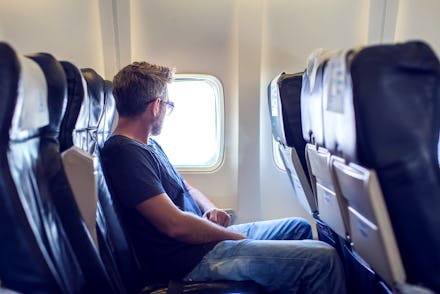This carry-on item can majorly affect how you feel after a long flight

Unless you have a spacious, comfy first- or business-class plane seat — and sometimes even if you do — the whole “air travel” part of traveling can take a real toll on your body. From sore necks and backs due to stiff seats, to dry skin due to arid cabin air, “the flight itself can affect the body in many ways,” said Dr. Yolanda Ragland, founder and CEO of Fix Your Feet. And in addition to the less serious physical effects of a flight is the possibility of something called Deep Vein Thrombosis (DVT), or blood clots in the inner veins.
DVT is particularly a risk on long flights, when you’re immobile, with your legs and feet down, for several hours at a time. “When the feet are in a dependent position, the veins increasingly expand to the point that they are unable to pump blood back to the heart for re-oxygenation,” Ragland said. “If the blood pools for too long, there is a possibility the blood can form a clot, creating...DVT. The DVT can cut off circulation in the leg or can travel to the lungs, causing a pulmonary embolism and become life-threatening.”
While the likelihood of DVT is rare, it does increase for travelers on long flights (and even more for certain high-risk groups, including pregnant people, smokers [and] people with high blood pressure, according to the American Society of Hematology). As the National Blood Clot Alliance reported, a research group from two Dutch medical centers found that frequent flyers were 3.65 times more likely to develop a clot than non-travelers. It’s enough of a risk that experts widely recommend wearing compression socks on long flights to help prevent it.
What are compression socks and what do they do?
Compression socks — also known as compression stockings — are designed specifically to help keep the blood flowing in your lower extremities. “They have elastic in them that [is] tighter down by the feet and less tight up by the calf,” said Dr. Paul Stein, a professor in osteopathic medical specialties at Michigan State University. “It’s a gradual sequence of pressure in there.”
That pressure plays an important role, Ragland explained, as it “prevent[s] the veins from over-expanding, thereby allowing blood flow back to the heart.” And, any concern about blood clots aside, that pressure can also help minimize uncomfortable swelling in your feet and legs.
What flight length necessitates compression socks?
If you’re only flying for a couple hours and you’re not already at a high-risk for blood clots, there’s not much need for compression socks (though you certainly can wear them). Otherwise, Stein recommended wearing them if your flight is about six hours or longer. “But if you’re a frequent flyer and you take four-hour flights every couple days, or every day, that adds up too,” he said. “It’s [thought that] if one takes several four-hour flights...in rapid succession,” that can have the same or similar effects on your veins as an isolated six-hour flight.
If you’re not quite sure whether or not you should wear compression socks, you can always talk to your doctor for advice — and, when in doubt, err on the side of compression.
What should you look for in compression socks?
Compression socks are widely available at this point — Stein noted you can get them at any medical supply store, but you can also buy them from all sorts of travel and retail companies (including companies like Vim & Vigr and Comrad, which have made a point of designing compression socks that look more cool than functional). In terms of what to look for, “They should go over the foot, [starting] at the toes and go up at least to the knee,” Stein said. “Some of them go up to the thigh, but they should at least go to the knees.” While some brands sell compression sleeves that cover the legs but not the feet, Stein recommended always going with the full sock versions. “The feet could swell and...clots could form in the veins low down by the ankles,” he said.
Compression socks are sold in varying levels of pressure (measured in millimeters of mercury, or mmHG), and according to the North American Thrombosis Forum, anywhere from 15 to 30 mmHg is recommended for travel. As for fit, per WebMD, they should be snug but not so tight that they’re painful; and they should be smooth and flat against your skin, and not folded or rolled on the top.
What else can you do to avoid blood clots?
While compression socks can be very helpful in preventing blood clots, Stein said you should also take additional measures on long flights. “Every hour or so, [travelers] should exercise their ankles to get the blood flowing,” he said. “Raise your foot up a little bit and go up and down with your foot — we call it dorsiflex and ventral flex — keep your legs still, and raise and lower your foot. ...That increases the blood flow in the veins.” It’s also important to get up and walk around every hour or so, and make sure you stay hydrated as well — two things that, Stein joked, go hand-in-hand. “The advantage of drinking a lot of water is it will make you get up and go to the bathroom periodically,” he said. (Regardless, hydration is important.)
Again, if you’re unsure about your risks or want help selecting compression socks, your best bet is to make an appointment with your doctor and talk it through — but regardless, it’s certainly something worth paying attention to, for the sake of your health and your vacation.